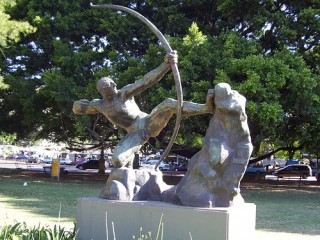
Emile-Antoine Bourdelle biography
Date of birth : 1861-10-30
Date of death : 1929-10-01
Birthplace : Montauban, France
Nationality : French
Category : Arts and Entertainment
Last modified : 2011-04-05
Credited as : Artist Sculptor, Strength, Victory, Liberty, and Eloquence, Auguste Rodin
The French sculptor Emile-Antoine Bourdelle was a pupil of Auguste Rodin and worked primarily in bronze and marble. He sought to restore monumentality to sculpture through an eclectic borrowing from both ancient Greek and medieval sculpture. Concerned with the public function of sculpture, Bourdelle reintroduced sculpture to its traditional outdoor and architectural settings.
Emile-Antoine Bourdelle was born in Montauban, France, the birthplace of Ingres, on October 30, 1861. His early interest in sculpture was inspired by his carpenter-cabinetmaker father. In fact, many of Bourdelle's earliest sculptural projects were in wood. A bust of the painter Ingres, completed when Bourdelle was just 15, won him a scholarship to study at the Ecole des Beaux-Arts in the nearby city of Toulouse. While in Toulouse he studied under the sculptor Maurette and executed numerous portrait busts before leaving for Paris in 1884.
The first years in Paris brought Bourdelle some success. He won an honorable mention at the exhibition of the Salon des Artistes Francais of 1885 and a medal at the Exposition Universelle of 1889. Bourdelle enrolled in the studio of the established master Alexandre Falguiere for a brief period before working first with Jules Dalou and, later, as a pupil and assistant to Auguste Rodin between the years 1893 and 1908.
In 1888 Bourdelle began his great series of portrait busts and masques of Beethoven which occupied him until his death in 1929. Bourdelle's interest in Beethoven attested to his Romantic impulses, and the heads and masques show a clear affinity to the malleable, additive quality of Rodin's sculpture.
In 1893 Bourdelle entered Rodin's studio as a practitioner. Rodin seems to have exerted a certain influence on Bourdelle's early work, and the relationship between the two men was characterized by a mutual admiration. In fact, Rodin became one of Bourdelle's earliest and most enthusiastic admirers, but Bourdelle's spirit was far too eclectic to follow the style of one master. His sculpture was soon to take its own course. Bourdelle had already begun studying the monumental sculpture of both Francois Rude and Jean-Baptiste Carpeaux as well as the great traditions of ancient Greek sculpture, particularly the Archaic, and medieval religious sculpture. Such an eclectic borrowing from the past accounted for the range of styles that characterized Bourdelle's sculpture—at times spirited and Romantic as in his Beethoven bronzes and, at other times, taut and severe like his Hercules, the Archer (1900-1907). In each case Bourdelle's bold expressive energy shows through the surface.
Bourdelle's study of the great ages of monumental sculpture led to his lifelong concern for the public function of sculpture and its relationship to an outdoor setting. In 1893 he began his studies for the Monument to the Defenders of Montauban, which commemorated the noble resistance of the people of Montauban in the Franco-Prussian War of 1870-1871. Considered his first masterpiece, the monument took eight years to finish. Elevated on a high pedestal in a public square, the figures possess at once an archaic severity and tautness combined with a powerful expressiveness that conveys the heroic struggle of a united people. Bourdelle's first masterpiece was part of a general trend in the late 19th century that favored public monuments memorializing those who lost their lives for France and the newly established Third Republic.
Bourdelle's most important commission came from Argentina in 1912. His Monument to General Alvear was executed between 1912 and 1923, but was not placed in the public square in Buenos Aires until 1925. This equestrian monument depicts General Alvear, a hero from the Argentinian war of independence of 1814-1815, riding atop a tall plinth flanked by four allegorical figures representing the civic virtues Strength, Victory, Liberty, and Eloquence.
The traditional bonds that linked sculpture with architecture also interested Bourdelle. In 1913 Bourdelle received another major commission to decorate the Champs Elysees theater with sculptural frieze panels depicting various aspects of the dramatic arts—Tragedy, Comedy, Dance, Music, and the Muses. All were couched in the style of Archaic Greek sculpture, but the static element of Greek sculpture, so loved by Bourdelle's contemporary Maillol, was enlivened by Bourdelle's fascination with the representation of movement and energy through the expressive use of line and straining bodies. It has even been suggested that these reliefs were inspired by the dance of Isadora Duncan. Moreover, in his panels entitled The Muses, Bourdelle's striding figures seem to foreshadow some of the figures seen in the paintings from Picasso's classical phase of the 1920s.
With Bourdelle's Virgin of the Offering (1922) one immediately detects his fascination with monumental religious sculpture. Raised on a hill above Niederbruch in Alsace, the Virgin of the Offering is a colossal work some 20 feet tall. Bourdelle took a sacred subject and imbued it with a nobility and grandeur rarely surpassed in sculpture.
Never one to actively pursue official honors, Bourdelle saw himself more akin to the Medieval craftsman. Nevertheless, he was honored in 1924 when he was made a commander of the Legion of Honor. Though official honors came late to Bourdelle, his influence was widespread.
Emile-Antoine Bourdelle died outside Paris at Vesinet on October 1, 1929. Two years later, in 1931, a major retrospective of his work was held in Paris. The Musee Bourdelle, where many of Bourdelle's sculptures can be seen, was opened in Paris in 1949.
















